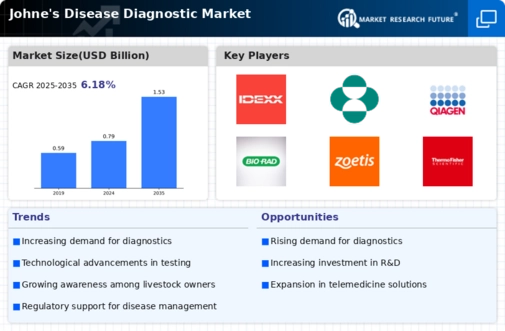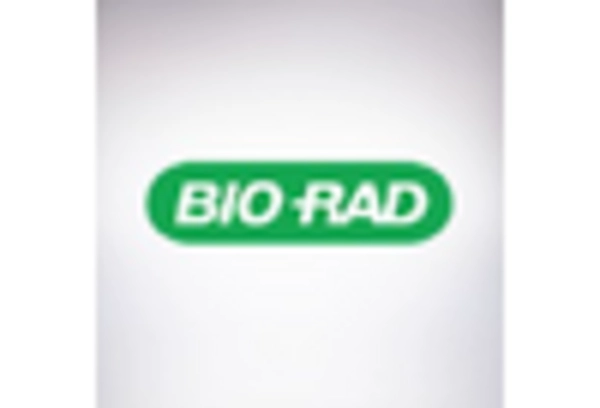The Johne's Disease Diagnostic Market is characterized by a competitive landscape that is increasingly shaped by innovation, strategic partnerships, and regional expansions. Key players such as IDEXX Laboratories (US), Neogen Corporation (US), and Zoetis (US) are at the forefront, leveraging their technological capabilities to enhance diagnostic accuracy and efficiency. IDEXX Laboratories (US) has positioned itself as a leader through continuous investment in research and development, focusing on advanced diagnostic solutions that cater to the evolving needs of veterinarians and livestock producers. Meanwhile, Neogen Corporation (US) emphasizes a strategy of broadening its product portfolio, which includes the integration of digital tools to streamline testing processes, thereby enhancing customer engagement and satisfaction. Zoetis (US) has adopted a more aggressive approach, focusing on strategic acquisitions to bolster its market presence and expand its diagnostic offerings, which collectively shapes a competitive environment that is both dynamic and multifaceted.
In terms of business tactics, companies are increasingly localizing manufacturing and optimizing supply chains to enhance operational efficiency and reduce costs. The market structure appears moderately fragmented, with several players vying for market share, yet the influence of major companies is substantial. This competitive structure allows for a diverse range of diagnostic solutions, catering to various segments within the livestock industry, while also fostering innovation through competition.
In August 2025, IDEXX Laboratories (US) announced the launch of a new rapid testing kit specifically designed for Johne's Disease, which is expected to significantly reduce the time required for diagnosis. This strategic move not only enhances IDEXX's product offerings but also reinforces its commitment to providing timely solutions for veterinarians, thereby potentially increasing its market share in the diagnostic segment. The introduction of this kit aligns with the growing demand for quick and reliable diagnostic tools in the livestock sector.
In July 2025, Neogen Corporation (US) entered into a partnership with a leading agricultural technology firm to develop an integrated platform that combines diagnostic testing with data analytics. This collaboration is poised to revolutionize how livestock producers manage herd health, as it allows for real-time monitoring and decision-making based on diagnostic results. Such strategic alliances indicate a shift towards more holistic approaches in disease management, which could enhance Neogen's competitive edge in the market.
In September 2025, Zoetis (US) completed the acquisition of a biotechnology firm specializing in molecular diagnostics for livestock diseases, including Johne's Disease. This acquisition is strategically significant as it not only expands Zoetis's diagnostic capabilities but also enhances its research and development pipeline. By integrating advanced molecular techniques, Zoetis is likely to improve the accuracy and speed of disease detection, thereby solidifying its position as a market leader.
As of October 2025, current competitive trends in the Johne's Disease Diagnostic Market are increasingly defined by digitalization, sustainability, and the integration of artificial intelligence. Companies are forming strategic alliances to enhance their technological capabilities and improve diagnostic accuracy. The competitive landscape is shifting from traditional price-based competition to a focus on innovation, technology, and supply chain reliability. This evolution suggests that future differentiation will hinge on the ability to deliver advanced, reliable diagnostic solutions that meet the growing demands of the livestock industry.

















Leave a Comment